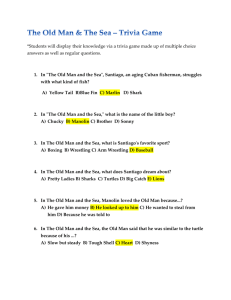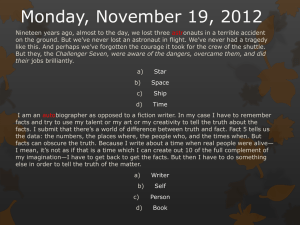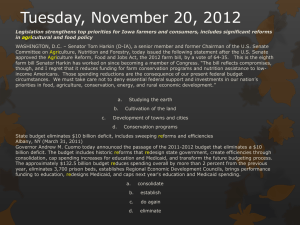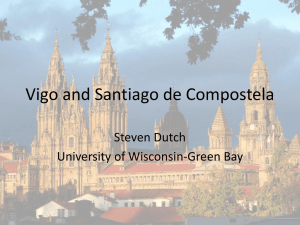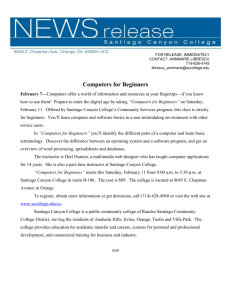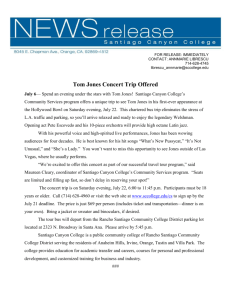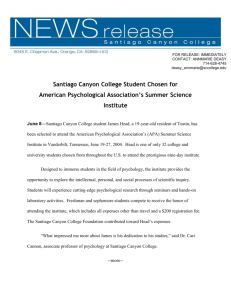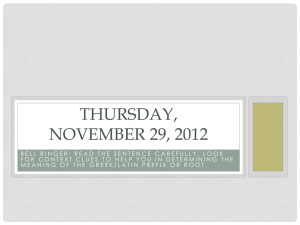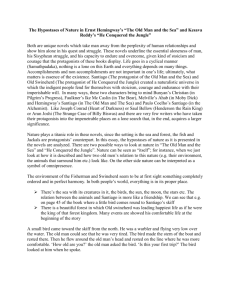OLD MAN AND THE SEA—Vocabulary
advertisement
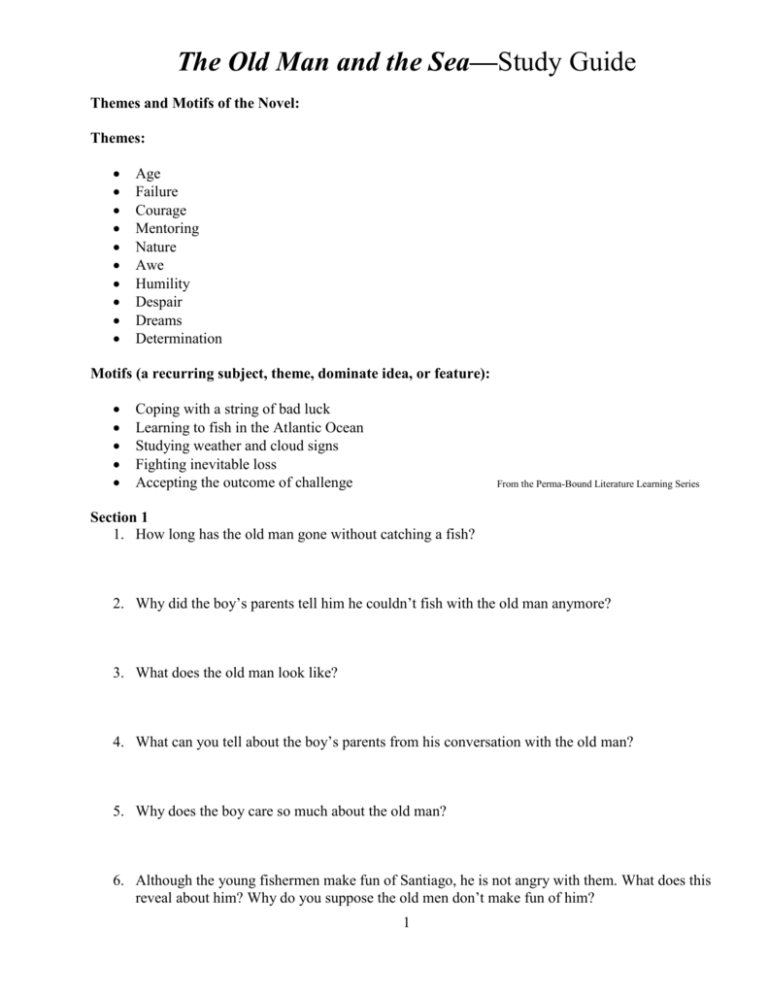
The Old Man and the Sea—Study Guide Themes and Motifs of the Novel: Themes: Age Failure Courage Mentoring Nature Awe Humility Despair Dreams Determination Motifs (a recurring subject, theme, dominate idea, or feature): Coping with a string of bad luck Learning to fish in the Atlantic Ocean Studying weather and cloud signs Fighting inevitable loss Accepting the outcome of challenge From the Perma-Bound Literature Learning Series Section 1 1. How long has the old man gone without catching a fish? 2. Why did the boy’s parents tell him he couldn’t fish with the old man anymore? 3. What does the old man look like? 4. What can you tell about the boy’s parents from his conversation with the old man? 5. Why does the boy care so much about the old man? 6. Although the young fishermen make fun of Santiago, he is not angry with them. What does this reveal about him? Why do you suppose the old men don’t make fun of him? 1 7. Explain the statement, “He was too simple to wonder when he had attained humility. But he knew he had attained it and knew it was not disgraceful and it carried no loss of true pride.” 8. What are Santiago’s living conditions like? 9. What small lie does the old man tell the boy? Why doesn’t the boy confront Santiago and make him admit he is in dire straits? 10. The boy assures the old man that he is the greatest fisherman, but the old man says, “I hope no fish will come along so great that he will prove us wrong.” This is an example of what technique? What might it predict? Section 2 11. In what way is Santiago technically superior to other fishermen? 12. How does the man-of-war bird help the old man? What does this reveal about his relationship with nature? 13. Hemingway’s style has been criticized and even satirized because it is simple and direct. How does the style of the long paragraph on page 35 differ from his usual style? 14. What is Santiago’s reaction to the Portugese-Man-of-War? How is his reaction different from any we have seen so far? 15. Why do you think Santiago talks to himself? 16. Why does Santiago wish Manolin was with him? 17. The sun sets and it begins to get cold. What might happen to Santiago during the night? 2 18. Santiago says on page 46, “tried not to think but only to endure.” What does this mean? 19. Santiago begins to pity the fish, and he remembers a sad time when he killed a female marlin in front of her mate. What does this tell you about him? 20. What vow does Santiago make regarding the fish? 21. Why was the slight injury to the old man’s right hand important? 22. What does Santiago call the fish on page 59? Section 3 23. On page 61, the old man says the light will make better weather for him than the fish. What do you think he means by this? 24. Santiago was finally able to see the fish. Describe what he saw. 25. Why do you think Santiago likes to sleep and dream about the lions? 26. Could the line, “Unless the sharks come, God pity him and me,” be foreshadowing? What would happen if the sharks came? 27. Compare the great arm wrestling match described on page 69 with the match between Santiago and the fish. How are the two matches similar? 28. How does Santiago know the fish is getting tired? 3 29. What do you think Santiago means by his comment on page 75, “I’m glad we do not have to kill the starts”? 30. Why couldn’t Santiago ever really get comfortable in the boat? 31. On page 84, why didn’t Santiago’s pain matter? 32. Summarize Santiago’s plan for harpooning the fish. 33. As Santiago dozes in the boat, he has three dreams. What are they, and what do you think they mean to Santiago and/or symbolize in this novel? 34. Santiago often expresses pity for the fish and calls it his friend. Why then, does he want to kill it so badly? Section 4 35. On page 91, Santiago pleads, “Last for me, head. Last for me. You never went.” Is this true as far as you know? Has Santiago been clear-headed throughout the novel? 36. Notice the contrast in the sentence on page 94, “Then the fish came alive, with his death in him.” How can someone or something coma alive as it is dying? 37. Consider the image on page 99 of Santiago side by side with the fish. What does this represent? 38. On page 101, the author says, “He was full of resolution but he had little hope.” What does this mean? 39. Discuss Santiago’s statement on page 103, “A man can be destroyed but not defeated.” How can this be true? 4 40. Hemingway describes the shovelnose shark attacking the fish, “He came like a pig to the trough.” What makes this simile effective? 41. On page 119, Santiago knows finally that he is beaten. Is his reaction one of despair? 42. What is Manolin’s reaction when he finds Santiago asleep in the morning? 43. How does Manolin comfort Santiago? 44. Most critics feel that Santiago is a hero. Define “hero” and explain whether or not you think Santiago is one. 45. “Grace under pressure” and “fighting the good fight” are themes found in most of Hemingway’s novels and stories. Explain how these themes are treated in The OldMan and the Sea. http://www.pennsville.k12.nj.us/PDF%20files/Th%20Old%20Man%20an%20the%20Sea%20study%20guide.pdf MEANING STUDY Below are words, phrases, sentences, or thought units that have a particular meaning in this novel. Explain each. 1. “I may not be as strong as I think,” the old man said. “But I know many tricks and I have resolution.” (p. 23) 2. He always thought of the seas as la mar which is what people call her in Spanish when they lover her. (p. 29) 3. No one should be alone in their old age, he thought. But it is unavoidable. (p. 48) 5 4. “Fish,” he said, “I love you and respect you very much. But I will kill you dead before this day ends.” (p. 54) 5. But, thank God, they are not as intelligent as we who kill them; although they are more noble and more able. (p. 63) 6. “It is not bad,” he said. “And pain does not matter to a man.” (p. 84) 7. With his mouth shut and his tail straight up and down we sail like brothers. (p. 99) 8. “But man is not made for defeat,” he said. “A man can be destroyed but not defeated.” (p. 103) 9. You killed him for pride and because you are a fisherman. (p. 105) 10. They were hateful sharks, bad smelling, scavengers as well as killers, and when they were hungry they would bite at an oar or the rudder of a boat. (pp. 107-108) COMPREHENSION STUDY Answer the following questions in your own words. There is not always a right answer. 1. How does Santiago describe the marlin he has caught? 2. What happens to the marlin after it is lashed to the skiff? 3. Why does Santiago fail to bring in the marlin? 4. How does Santiago prove his skill? 6 5. How does Santiago relate to Manolin? 6. Why does the old man dream of lions? 7. Why does Santiago talk to himself? 8. What is the meaning of the conclusion? 9. Is Santiago religious? Explain your answer. 10. How does Hemingway describe suffering? From the Perma-Bound Literature Learning Series 7 OLD MAN AND THE SEA—Vocabulary Page 9 1. skiff 2. salao 3. gaff 4. furled 5. gaunt 6. benevolent Page 10 7. erosions Page 12 8. thwart Page 13 9. attained 10. humility Page 15 11. guano Page 16 12. dressed out Page 17 13. terminal Page 23 14. resolution Page 25 15. oakum 16. Canary Islands Page 28 17. phosphorescence 18. fathoms 8 19. congregated Page 29 20. la mar 21. buoys Page 30 22. bonito 23. albacore Page 31 24. plummets Page 33 25. man-of-war bird Page 35 26. plankton 27. iridescent 28. gelatinous Page 36 29. carapaced 30. loggerheads Page 37 31. mysticism 32. grippes Page 39 33. virtue Page 40 34. prisms 35. myriad 36. annulled Page 41 37. bight 38. shank 39. hand-forged 9 Page 43 40. imperceptible Page 44 41. pivoted Page 45 42. bitt Page 47 43. intolerable Page 49 44. scythe 45. gaffed 46. rapier 47. hoisted Page 50 48. treachery Page 51 49. gunwale Page 52 50. surge 51. coagulated Page 60 52. accord 53. undulation Page 62 54. ptomaine Page 76 55. comparatively Page 78 56. maw 57. leprous 10 Page 79 58. astern Page 83 59. ceding 60. friction Page 90 61. placid Page 94 62. shoal Page 97 63. boom Page 99 64. cumulus 65. cirrus Page 101 66. resolution Page 102 67. malignancy Page 107 68. pectoral Page 109 69. cartilage Page 117 70. perceptible Page 125 71. lance 11
